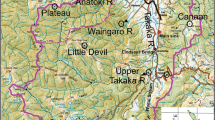Abstract
Groundwater meiofauna washed out of springs was studied by means of spring water filtration. The principal interest was a quantitative analysis of the number and diversity of outwash fauna in relationship to hydrological conditions. In addition, a comparative analysis was made of outwash fauna of different outlets of the same hydrological system. The spring complex studied is part of the Centraal Plateau in the southern-most part of The Netherlands. This area is characterized by, for The Netherlands, relatively high hydraulic heads and large permeability of aquifers. Influence of human activities (agriculture) in the recharge area was demonstrated by elevated concentrations of nitrate, chloride, and sulphate in the spring waters. No traces of groundwater pollution by heavy metals or pesticides were found. Temporal variation of meiofauna outwash was studied in a single rheocrene spring during one year. This rheocrene had a relatively large and constant discharge (1300±8 ¦h−1). Meiofauna numbers fluctuated between 110–240 ind. m−3. Considerable differences in meiofauna numbers in a one-off analysis of different springs (rheocrenes and helocrenes) were found. Numbers ranged from 140 to 5800 org. m−3 and an inverse relationship with the amount of water discharged was shown. Organisms in the water filtrates were of multiple origin: aquifer(e.g. Niphargus, Parastenocaris), benthic spring head habitats (e.g. Gammarus, Chironomidae), and (saturated) soils near the outlets (e.g. Criconomatidae). Meiofauna abundance and composition is discussed in relation to hydrology and spring head morphology. A semi-quantitative analysis of outwash aquifer fauna was masked by the presence of epigean elements or elements of unclear origin. The outwash fauna of rheocrenes of large discharge supposedly is the most representative for the aquifer. Adaptations of hypogean populations to oligotrophic porous environments and the consequences for drift of juvenile stages is discussed.
Similar content being viewed by others
References
ELLIOTT, J. M., 1983. Some methods for the statistical analysis of samples of benthic invertebrates. Freshwater Biological Association, Scientific Publication 25 (reprint with minor corrections of second edition)
GIBERT, J., J.A. STANFORD, M.-J. DOLE-OLIVIER and J.V. WARD, 1994. Basic attributes of groundwater ecosystems and prospects for research. In: J. Gibert, D.L. Danielopol and J.A. Stanford, Eds., Groundwater ecology. Academic Press Inc., San Diego, p. 8–40.
GLATZEL, Th., 1990. On the biology ofParastenocaris phyllura Kiefer (Copepoda,Harpacticoida). Stygologia, 5: 131–136.
HENDRIX, W.P.A.M., 1985. Het grondwater van het Centraal Plateau (Z-Limburg). Report Geographic Institute, State University Utrecht, p. 1–207 (incl. 12 appendices).
HIGGENS, R.P. and H. THIEL, 1988. Introduction to the study of meiofauna. Smithsonian Institution Press Washington D.C.
HUSMANN, S., 1956. Untersuchungen über die Grundwasserfauna zwischen Harz und Weser. Arch. Hydrobiol., 52: 1–184.
JONGMANS, W.J., 1931. Geologische onderzoekingen voor de Nederlandse spoorwegen in Limburg in verband met bodemafschuivingen. Spoor-en Tramwegen 3, 4, 5 en 6, Den Haag.
KURECK, A., 1967. Über die tagesperiodische ausdrift vonNiphargus aquilex schellenbergi Karaman aus quellen. Z. Morph. Ökol. Tiere 58: 247–262.
MAGNIEZ, G., 1974. Observations surStenasellus virei dans ses biotopes naturels (Crustacea Isopoda Asellota des eaux souterraines). Int. J. Speleol., 6: 115–171.
MATHIEU, J., P. MARMONIER, R. LAURENT, and D. MARTIN, 1991. Récolte du matériel biologique aquatique souterrain et stratégie d'échantillonnage. Hydrogéologie 3: 187–200.
MESTROV, M., 1962. Un nouveau milieu aquatique souterrain: le biotope hypotelminorhéique. C.R. Acad. Sc. Paris, 254: 2677–2679.
MÜLLER, K., A. KURECK and A. MÜLLER-HAECKEL, 1963. Zur Tagesperiodik vonNiphargus aquilex schellenbergi Karaman (Gammaridae, Amphipoda). Naturwissensch., 50: 579–580.
NOL, W., 1939. Die Grundwasserfauna des Maingebietes. Mitteil. Nat. Mus. Aschaffenburg, 3/26.
NOTENBOOM, J., 1982. Een inventarisatie van de fauna in een aantal Zuid-Limburgse waterputten. Natuurhist. Maandbl. 71: 27–32.
ROUCH, R., 1986. Sur l'écologie des eaux souterraines dans le karst. Stygologia 2: 352–398.
SCHMID-ARAYA, J.M., 1993. Benthic rotifera inhabiting the bed sediments of a mountain gravel stream. Jber. Biol. Stn. Lunz, 14: 75–101.
SCHMINKE, H. H. and J. NOTENBOOM, 1990. Parastenocarididae (Copepoda, Harpacticoida) in The Netherlands. Bijdragen tot de Dierkunde, 60: 299–304.
SYSTAT for Windows: Statistics, Version 5 Edition. Evanston, II: SYSTAT, Inc., 1992.
Author information
Authors and Affiliations
Rights and permissions
About this article
Cite this article
Notenboom, J., Hendrix, W. & Folkerts, A.J. Meiofauna assemblages discharged by springs from a phreatic aquifer system in the Netherlands. Netherlands Journal of Aquatic Ecology 30, 1–13 (1996). https://doi.org/10.1007/BF02092142
Issue Date:
DOI: https://doi.org/10.1007/BF02092142




